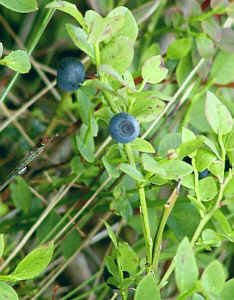
Plant Description
Caution & Interaction

Latin (botanical) name:
Vaccinium myrtillus
Common names: Whortleberry, Black Whortles, Whinberry, Trackleberry, Huckleberry, Hurts, Bleaberry, Hurtleberry, Airelle, Vaccinium Frondosum, Blueberries
Plant Description: Bilberry can be found in the mountainous regions of Europe. It is a small shrub with wiry branches and rarely grows more than 12 inches in height. The leaves are globe shaped with a waxy surface and the berries are blackish-blue. Berries can sometimes be hidden from view by the grayish bloom it yields when ripe. The fruit is about the size of a black currant and can be eaten raw, but has a slightly acidic taste. When cooked with sugar, it makes a very nice preserve.
Medicinal Properties & Uses: For more than a thousand years, Bilberry has been used throughout Europe for the treatment of scurvy. The leaves can be used in a syrupy tea to combat diarrhea and dysentery. The leaves and bark of the root are sometimes decocted to apply to ulcers and ulcerations of the mouth. In more recent years, it has been used for the treatment of eye ailments such as cataracts, glaucoma, macular degeneration, poor night vision, and retinopathy.
Dosage: 20-40 drops in water or juice, 2-3 times daily or as needed. Shake well before using.
Cautions & Interactions: Keep out of reach of children.
Efficacy Studies & Other Clinical Data:
Helpful Links:
Disclaimer (U.S. Only): These statements have not been evaluated by the FDA. These products are not intended to diagnose, cure, treat, or prevent any disease.
Common names: Whortleberry, Black Whortles, Whinberry, Trackleberry, Huckleberry, Hurts, Bleaberry, Hurtleberry, Airelle, Vaccinium Frondosum, Blueberries
Plant Description: Bilberry can be found in the mountainous regions of Europe. It is a small shrub with wiry branches and rarely grows more than 12 inches in height. The leaves are globe shaped with a waxy surface and the berries are blackish-blue. Berries can sometimes be hidden from view by the grayish bloom it yields when ripe. The fruit is about the size of a black currant and can be eaten raw, but has a slightly acidic taste. When cooked with sugar, it makes a very nice preserve.
Medicinal Properties & Uses: For more than a thousand years, Bilberry has been used throughout Europe for the treatment of scurvy. The leaves can be used in a syrupy tea to combat diarrhea and dysentery. The leaves and bark of the root are sometimes decocted to apply to ulcers and ulcerations of the mouth. In more recent years, it has been used for the treatment of eye ailments such as cataracts, glaucoma, macular degeneration, poor night vision, and retinopathy.
Dosage: 20-40 drops in water or juice, 2-3 times daily or as needed. Shake well before using.
Cautions & Interactions: Keep out of reach of children.
Efficacy Studies & Other Clinical Data:
Helpful Links:
Disclaimer (U.S. Only): These statements have not been evaluated by the FDA. These products are not intended to diagnose, cure, treat, or prevent any disease.